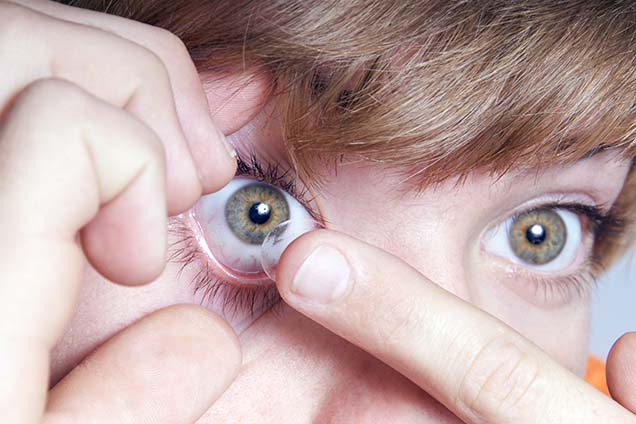
Accommodation
Spontaneous variation of the radius of curvature of the lens according to the distance at which the objects are observed. This variation allows the focusing of the image on the retina, a condition of a clear vision at all distances.
![]()
Afocal
A lens or an optical system that has no power. Example: Non-corrective sunglasses are equipped with afocal lenses.
![]()
Alloy
Product of a metallic character resulting from the incorporation of one or more elements (metallic or not) to a metal.
![]()
Amblyopia
Decreased visual acuity making images reaching the brain are of poor quality. This disorder can come from an eye disease or a visual defect gone unnoticed in infancy.
![]()
Ametropia
Optical abnormality of the eye such that the image is not formed on the retina (myopia, hyperopia, presbyopia) or is deformed (astigmatism).
![]()
Allergenic
Substance that does not cause allergy.
![]()
Intra-corneal rings
Intra-corneal rings are small semicircular rigid segments in PMMA (plastic).
Their place in the therapeutic management of keratoconus is between contact lens intolerance and the use of corneal transplantation.
They are introduced into the very thickness of the cornea, the intra-corneal rings are intended to strengthen it. Well positioned, they allow to retension the central cornea. The importance and irregularity of corneal astigmatism are thus reduced.
![]()
Astigmatism
Defect of radius of curvature on the cornea inducing a deformation of the image formed on the retina: a circle gives the image of an oval.
![]()
Cataract
Ocular affection resulting in opacification of the crystalline lens or its capsule, producing partial or total blindness, particularly affecting the elderly. Currently cataracts are operated with 99% chance of success.
![]()
Collyre
Médicament liquide préparé pour être appliqué sur l’œil.
![]()
Cornea
Very thin transparent dome covering the anterior part of the eyeball.
![]()
Crystalline
Constituent element of the eye, in the form of a biconvex lens, whose curvature is modifiable under the action of the ciliary muscles, and which concentrates the light rays on the retina.
![]()
Cross Linking
Surgical technique for the treatment of keratoconus based on the principle of a photochemical reaction between a photosensitive product (Riboflavin) deposited on the keratoconic cornea and a session of UVA (long ultraviolet) ranging from 9 to 30 min depending on the machine used.
The purpose of the treatment is to stiffen the collagen by creating chemical bridges between the collagen fibrils thanks to the polymerizing action of phototherapy (principle of Cross Linking).
Cross Linking does not cure keratoconus, its sole purpose is to stabilize it to prevent progression to corneal transplantation.
![]()
Macular degeneration
It does not blind but disrupts the vision of detail. It evolves towards a loss of central vision.
![]()
Divergent
Who diverges, departs. It is said of two rays that move apart.
![]()
Glaucoma
Disease of the eye characterized by an increase of the internal pressure causing atrophy of the head, the optic nerve and a decrease of the visual field, up to the blindness.
![]()
Hyperopia
Anomaly of vision causing the image to form behind the retina and not on it. It’s the opposite of myopia. A hyperopic can have a good vision if the accommodative power is sufficient. The hyperopic usually sees better from a distance than from near.
![]()
Hypoallergenic
Not likely to contain substances capable of triggering an allergic reaction.
![]()
Iris
Circularly colored circular membrane of the eye and pierced in the middle of an orifice, the pupil. The iris plays the role of a diaphragm.
![]()
Contact lens
Small cupolas calculated optically and adapted to the eyes of each wearer. They are placed on the film of tears that covers the cornea. Today, they can correct any visual defects.
![]()
Monocular
Vision mode with one eye.
![]()
Myopia
Anomaly of the sight which makes that the distant objects are disturbed. (Myopia comes from too much convergence of the lens, which forms the images in front of the retina). Wearing diverging lenses corrects this anomaly.
![]()
Edema
Excessive serous infiltration of subcutaneous and submucosal tissues and may affect the tissues of the eye.
![]()
Eye
Organ of sight composed of an eyeball (pupil, lens, retina) and its appendages (eyelids).
![]()
Ophthalmologist
Specialist for eye diseases and eye surgery (synonym: oculist)
![]()
Orthoptist
Specialist in the rehabilitation of the eye.
![]()
Photochromic
The ability of a mineral, organic or polycarbonate lens to darken or lighten depending on the brightness.
![]()
Polarisant
Les verres polarisants permettent la suppression de l’éblouissement dû à la réverbération de la lumière.
![]()
Presbyopia
Anomaly of vision due to aging of the lens which thickens. By stiffening, it accommodates more difficult and we see less and less closely. From the age of 45, no one escapes presbyopia.
![]()
Pupil
Central orifice of the iris behaving like a camera diaphragm, its diameter varies according to the brightness.
![]()
Retina
Plated at the back of the eye, on its inner wall, this hypersensitive membrane plays a key role in the perception of lights, details, shapes, movements.
![]()
Strabismus
Anomaly of binocular vision characterized by the deviation of one or both eyes. It can be corrected from the age of 5 to 6 months.
![]()
Ultraviolet
Radiations invisible to the human eye placed in the light spectrum beyond the violet. These radiations are not free of danger.
![]()
Toric glass
Meniscus lens with one of the faces is toric.
![]()
Multifocal Glasses
Set of lenses, bifocals, trifocals and progressive that allow the wearer to see clearly at several distances.
![]()
Progressive glasses
Their power varies progressively between far vision for the upper part of the glass and near vision for the lower part. Without optical demarcation, so aesthetic, they serve to correct the presbyopia.
![]()
Unifocal glasses
Single-focus glasses correcting ametropia. The power of the glass is the same over the entire surface. The presbyopic sees closely through all the points of the glass but from about fifty centimeters, the vision becomes blurred.